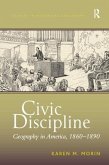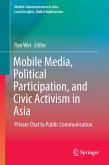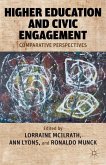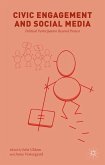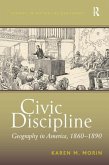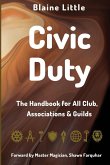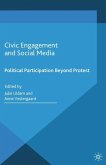Civic Discourse
Multiculturalism, Cultural Diversity, and Global Communication, Volume 1
Herausgeber: Sitaram, K. S.; Prosser, Michael H.
Civic Discourse
Multiculturalism, Cultural Diversity, and Global Communication, Volume 1
Herausgeber: Sitaram, K. S.; Prosser, Michael H.
- Gebundenes Buch
- Merkliste
- Auf die Merkliste
- Bewerten Bewerten
- Teilen
- Produkt teilen
- Produkterinnerung
- Produkterinnerung
Links the role of civic discourse and communication to their connections to civil society, both domestically and on a global basis.
Andere Kunden interessierten sich auch für
![Civic Discipline Civic Discipline]() Karen M. MorinCivic Discipline70,99 €
Karen M. MorinCivic Discipline70,99 €![Mobile Media, Political Participation, and Civic Activism in Asia Mobile Media, Political Participation, and Civic Activism in Asia]() Mobile Media, Political Participation, and Civic Activism in Asia75,99 €
Mobile Media, Political Participation, and Civic Activism in Asia75,99 €![Higher Education and Civic Engagement Higher Education and Civic Engagement]() Higher Education and Civic Engagement41,99 €
Higher Education and Civic Engagement41,99 €![Civic Engagement and Social Media Civic Engagement and Social Media]() Civic Engagement and Social Media38,99 €
Civic Engagement and Social Media38,99 €![Civic Discipline Civic Discipline]() Karen M. MorinCivic Discipline196,99 €
Karen M. MorinCivic Discipline196,99 €![Civic Duty Civic Duty]() Blaine LittleCivic Duty16,99 €
Blaine LittleCivic Duty16,99 €![Civic Engagement and Social Media Civic Engagement and Social Media]() Civic Engagement and Social Media38,99 €
Civic Engagement and Social Media38,99 €-
-
-
Links the role of civic discourse and communication to their connections to civil society, both domestically and on a global basis.
Hinweis: Dieser Artikel kann nur an eine deutsche Lieferadresse ausgeliefert werden.
Hinweis: Dieser Artikel kann nur an eine deutsche Lieferadresse ausgeliefert werden.
Produktdetails
- Produktdetails
- Verlag: Praeger
- Seitenzahl: 512
- Erscheinungstermin: 5. Januar 1999
- Englisch
- Abmessung: 240mm x 161mm x 32mm
- Gewicht: 928g
- ISBN-13: 9781567504095
- ISBN-10: 1567504094
- Artikelnr.: 25599251
- Herstellerkennzeichnung
- Libri GmbH
- Europaallee 1
- 36244 Bad Hersfeld
- gpsr@libri.de
- Verlag: Praeger
- Seitenzahl: 512
- Erscheinungstermin: 5. Januar 1999
- Englisch
- Abmessung: 240mm x 161mm x 32mm
- Gewicht: 928g
- ISBN-13: 9781567504095
- ISBN-10: 1567504094
- Artikelnr.: 25599251
- Herstellerkennzeichnung
- Libri GmbH
- Europaallee 1
- 36244 Bad Hersfeld
- gpsr@libri.de
K.S. SITARAM is Professor of Radio-Television at Southern Illinois University at Carbondale. MICHAEL H. PROSSER is Kern Professor in Communications at the Rochester Institute of Technology and Professor at the University of Virginia.
Foreword, Tapio Varis
Preface
Introduction
Multiculturalism for a Higher Humanity, K. S. Sitaram
SECTION I OVERVIEW: INTERCULTURAL, MULTICULTURAL AND GLOBAL COMMUNICATION
THEORIES AND ISSUE
The Problem of Ethics in Intercultural Communication, Kenneth D. Day
Hofsted's Dimensions: An Examination and Critical Analysis, Roberta Bell
Ross and Sandra L. Faulkner
The Ideology of Difference in Current Discourse, William Over
Multicultural Issues in the Study of Cross Cultural Communication, Eveline
Lang
English as the Dominant Language for Intercultural Communication: Prospects
for the Next Century, Nobleza Asuncion-Lande
How Global Is Global?
A Critical Look at the Language and Ideology of Globalization, Aixa L.
Rodríguez-Rodríguez
Contemporary Advocacy and Intercultural Communication, William Ove
Promoting Intercultural Communication in the Multicultural Classroom: Using
Discomfort as a Learning Tool, Ruth Johnson
The Use and Misuse of Questionnaires in Intercultural Training, John Bing
SECTION II OVERVIEW: CULTURAL DIVERSITY: ETHNICITY, RACE, AND GENDER
Fostering Respects for Other Cultures in Teaching Intercultural
Communication, Kenneth D. Day
Speech Anxiety among International Students, Laurie Wilfred Hodge
Latinos in the United States.: Diversity, Cultural Patterns, and
Misconceptions, Rosita D. Albert
Critical Discourse Analysis: Racism and the Ethos of Equality, Ray T.
Donahue
The Black Professional: An Analysis of the Communicative Strategies Used in
Cross-Race Mentoring, Kathy W. Brooks
African-American Discourses on Problematic Relations with Whites, Richard
Buttny and Princess L. Williams
Turn Taking and the Extended Pause: A Study of Interpersonal Communication
Styles across Generations on the Warm Springs Indian Reservation, Gordon
Scott McLean
The Nature and Culture of Conflict: The Indian Case: Some Communication
Implications, Clospet Ramesh
SECTION III OVERVIEW: COMPARATIVE STUDIES OF CULTURE AND COMMUNICATION
Intercultural Relationships across Gender: A Look at the Communicative
Parallels that Characterize Intercultural and Cross-Gender Relations,
Roberta Bell Ross and Sandra L. Faulkner
Hofstede's Intercultural Dimensions and the Decision-Making Process:
Americans and Malaysians in a Cooperative University Setting, Kim Hughes
Wilhelm
Educators Crossing Cultures: Evaluation of Past Work and Guidelines for the
Future, Ekaterina Ognianova
Artifacts of Intercultural Communication between U.S. and International
University Students, Deradirek Ekachai, Mary Hinchcliff-Pelias and Norman
Greer
The Communication Stereotypes of Whites and Asians in the White-dominant
Classroom, Young-ok Yum
A Comparative Analysis of Rhetorical Theory in China and the United States,
D. Ray Heisey
SECTION IV OVERVIEW: MULTICULTURAL AND MULTINATIONAL ORGANIZATIONS
Women's Rights as Human Rights in the United Nations: Three Perspectives,
Barbara S. Monfils
The AID Communication Seminars as a Factor in the Development of
Intercultural Communication Study, 1958-1978, Huber W. Ellingsworth
The Global Economic Society and Polycultural Teams, R. Ray Gehani
Can We Talk? A Guide for the Twenty-First Century CEO Managing in a
Multicultural Environment, Kathy W. Brooks
Jumping Off the Bridge: Rites of Passage and Other Indicators of
Organizational Culture, David R. Neumann
SECTION V OVERVIEW: MULTICULTURALISM, CULTURAL DIVERSITY, AND HEALTH
Multicultural Issues in Health Communication, Elizabeth N. Kunimoto
The Process of Bridging Global Multiculturalism, Communication, and
Disability, William Olubodun
Deaf Culture, Pluralism, and the Field of Communication, Cindy Campbell and
Rachel Friend
Why Minorities Aren't Choosing Nursing Careers: Intercultural
Communication, Recruitment, and Minority Underrepresentation in Nursing,
Mary Henderson Askew
Epilogue: Multiculturalism, Cultural Diversity, and the Sharing of Power in
the Global Society, Michael H. Prosser
Author Index
Subject Index
About the Contributors
About the Editors.
Preface
Introduction
Multiculturalism for a Higher Humanity, K. S. Sitaram
SECTION I OVERVIEW: INTERCULTURAL, MULTICULTURAL AND GLOBAL COMMUNICATION
THEORIES AND ISSUE
The Problem of Ethics in Intercultural Communication, Kenneth D. Day
Hofsted's Dimensions: An Examination and Critical Analysis, Roberta Bell
Ross and Sandra L. Faulkner
The Ideology of Difference in Current Discourse, William Over
Multicultural Issues in the Study of Cross Cultural Communication, Eveline
Lang
English as the Dominant Language for Intercultural Communication: Prospects
for the Next Century, Nobleza Asuncion-Lande
How Global Is Global?
A Critical Look at the Language and Ideology of Globalization, Aixa L.
Rodríguez-Rodríguez
Contemporary Advocacy and Intercultural Communication, William Ove
Promoting Intercultural Communication in the Multicultural Classroom: Using
Discomfort as a Learning Tool, Ruth Johnson
The Use and Misuse of Questionnaires in Intercultural Training, John Bing
SECTION II OVERVIEW: CULTURAL DIVERSITY: ETHNICITY, RACE, AND GENDER
Fostering Respects for Other Cultures in Teaching Intercultural
Communication, Kenneth D. Day
Speech Anxiety among International Students, Laurie Wilfred Hodge
Latinos in the United States.: Diversity, Cultural Patterns, and
Misconceptions, Rosita D. Albert
Critical Discourse Analysis: Racism and the Ethos of Equality, Ray T.
Donahue
The Black Professional: An Analysis of the Communicative Strategies Used in
Cross-Race Mentoring, Kathy W. Brooks
African-American Discourses on Problematic Relations with Whites, Richard
Buttny and Princess L. Williams
Turn Taking and the Extended Pause: A Study of Interpersonal Communication
Styles across Generations on the Warm Springs Indian Reservation, Gordon
Scott McLean
The Nature and Culture of Conflict: The Indian Case: Some Communication
Implications, Clospet Ramesh
SECTION III OVERVIEW: COMPARATIVE STUDIES OF CULTURE AND COMMUNICATION
Intercultural Relationships across Gender: A Look at the Communicative
Parallels that Characterize Intercultural and Cross-Gender Relations,
Roberta Bell Ross and Sandra L. Faulkner
Hofstede's Intercultural Dimensions and the Decision-Making Process:
Americans and Malaysians in a Cooperative University Setting, Kim Hughes
Wilhelm
Educators Crossing Cultures: Evaluation of Past Work and Guidelines for the
Future, Ekaterina Ognianova
Artifacts of Intercultural Communication between U.S. and International
University Students, Deradirek Ekachai, Mary Hinchcliff-Pelias and Norman
Greer
The Communication Stereotypes of Whites and Asians in the White-dominant
Classroom, Young-ok Yum
A Comparative Analysis of Rhetorical Theory in China and the United States,
D. Ray Heisey
SECTION IV OVERVIEW: MULTICULTURAL AND MULTINATIONAL ORGANIZATIONS
Women's Rights as Human Rights in the United Nations: Three Perspectives,
Barbara S. Monfils
The AID Communication Seminars as a Factor in the Development of
Intercultural Communication Study, 1958-1978, Huber W. Ellingsworth
The Global Economic Society and Polycultural Teams, R. Ray Gehani
Can We Talk? A Guide for the Twenty-First Century CEO Managing in a
Multicultural Environment, Kathy W. Brooks
Jumping Off the Bridge: Rites of Passage and Other Indicators of
Organizational Culture, David R. Neumann
SECTION V OVERVIEW: MULTICULTURALISM, CULTURAL DIVERSITY, AND HEALTH
Multicultural Issues in Health Communication, Elizabeth N. Kunimoto
The Process of Bridging Global Multiculturalism, Communication, and
Disability, William Olubodun
Deaf Culture, Pluralism, and the Field of Communication, Cindy Campbell and
Rachel Friend
Why Minorities Aren't Choosing Nursing Careers: Intercultural
Communication, Recruitment, and Minority Underrepresentation in Nursing,
Mary Henderson Askew
Epilogue: Multiculturalism, Cultural Diversity, and the Sharing of Power in
the Global Society, Michael H. Prosser
Author Index
Subject Index
About the Contributors
About the Editors.
Foreword, Tapio Varis
Preface
Introduction
Multiculturalism for a Higher Humanity, K. S. Sitaram
SECTION I OVERVIEW: INTERCULTURAL, MULTICULTURAL AND GLOBAL COMMUNICATION
THEORIES AND ISSUE
The Problem of Ethics in Intercultural Communication, Kenneth D. Day
Hofsted's Dimensions: An Examination and Critical Analysis, Roberta Bell
Ross and Sandra L. Faulkner
The Ideology of Difference in Current Discourse, William Over
Multicultural Issues in the Study of Cross Cultural Communication, Eveline
Lang
English as the Dominant Language for Intercultural Communication: Prospects
for the Next Century, Nobleza Asuncion-Lande
How Global Is Global?
A Critical Look at the Language and Ideology of Globalization, Aixa L.
Rodríguez-Rodríguez
Contemporary Advocacy and Intercultural Communication, William Ove
Promoting Intercultural Communication in the Multicultural Classroom: Using
Discomfort as a Learning Tool, Ruth Johnson
The Use and Misuse of Questionnaires in Intercultural Training, John Bing
SECTION II OVERVIEW: CULTURAL DIVERSITY: ETHNICITY, RACE, AND GENDER
Fostering Respects for Other Cultures in Teaching Intercultural
Communication, Kenneth D. Day
Speech Anxiety among International Students, Laurie Wilfred Hodge
Latinos in the United States.: Diversity, Cultural Patterns, and
Misconceptions, Rosita D. Albert
Critical Discourse Analysis: Racism and the Ethos of Equality, Ray T.
Donahue
The Black Professional: An Analysis of the Communicative Strategies Used in
Cross-Race Mentoring, Kathy W. Brooks
African-American Discourses on Problematic Relations with Whites, Richard
Buttny and Princess L. Williams
Turn Taking and the Extended Pause: A Study of Interpersonal Communication
Styles across Generations on the Warm Springs Indian Reservation, Gordon
Scott McLean
The Nature and Culture of Conflict: The Indian Case: Some Communication
Implications, Clospet Ramesh
SECTION III OVERVIEW: COMPARATIVE STUDIES OF CULTURE AND COMMUNICATION
Intercultural Relationships across Gender: A Look at the Communicative
Parallels that Characterize Intercultural and Cross-Gender Relations,
Roberta Bell Ross and Sandra L. Faulkner
Hofstede's Intercultural Dimensions and the Decision-Making Process:
Americans and Malaysians in a Cooperative University Setting, Kim Hughes
Wilhelm
Educators Crossing Cultures: Evaluation of Past Work and Guidelines for the
Future, Ekaterina Ognianova
Artifacts of Intercultural Communication between U.S. and International
University Students, Deradirek Ekachai, Mary Hinchcliff-Pelias and Norman
Greer
The Communication Stereotypes of Whites and Asians in the White-dominant
Classroom, Young-ok Yum
A Comparative Analysis of Rhetorical Theory in China and the United States,
D. Ray Heisey
SECTION IV OVERVIEW: MULTICULTURAL AND MULTINATIONAL ORGANIZATIONS
Women's Rights as Human Rights in the United Nations: Three Perspectives,
Barbara S. Monfils
The AID Communication Seminars as a Factor in the Development of
Intercultural Communication Study, 1958-1978, Huber W. Ellingsworth
The Global Economic Society and Polycultural Teams, R. Ray Gehani
Can We Talk? A Guide for the Twenty-First Century CEO Managing in a
Multicultural Environment, Kathy W. Brooks
Jumping Off the Bridge: Rites of Passage and Other Indicators of
Organizational Culture, David R. Neumann
SECTION V OVERVIEW: MULTICULTURALISM, CULTURAL DIVERSITY, AND HEALTH
Multicultural Issues in Health Communication, Elizabeth N. Kunimoto
The Process of Bridging Global Multiculturalism, Communication, and
Disability, William Olubodun
Deaf Culture, Pluralism, and the Field of Communication, Cindy Campbell and
Rachel Friend
Why Minorities Aren't Choosing Nursing Careers: Intercultural
Communication, Recruitment, and Minority Underrepresentation in Nursing,
Mary Henderson Askew
Epilogue: Multiculturalism, Cultural Diversity, and the Sharing of Power in
the Global Society, Michael H. Prosser
Author Index
Subject Index
About the Contributors
About the Editors.
Preface
Introduction
Multiculturalism for a Higher Humanity, K. S. Sitaram
SECTION I OVERVIEW: INTERCULTURAL, MULTICULTURAL AND GLOBAL COMMUNICATION
THEORIES AND ISSUE
The Problem of Ethics in Intercultural Communication, Kenneth D. Day
Hofsted's Dimensions: An Examination and Critical Analysis, Roberta Bell
Ross and Sandra L. Faulkner
The Ideology of Difference in Current Discourse, William Over
Multicultural Issues in the Study of Cross Cultural Communication, Eveline
Lang
English as the Dominant Language for Intercultural Communication: Prospects
for the Next Century, Nobleza Asuncion-Lande
How Global Is Global?
A Critical Look at the Language and Ideology of Globalization, Aixa L.
Rodríguez-Rodríguez
Contemporary Advocacy and Intercultural Communication, William Ove
Promoting Intercultural Communication in the Multicultural Classroom: Using
Discomfort as a Learning Tool, Ruth Johnson
The Use and Misuse of Questionnaires in Intercultural Training, John Bing
SECTION II OVERVIEW: CULTURAL DIVERSITY: ETHNICITY, RACE, AND GENDER
Fostering Respects for Other Cultures in Teaching Intercultural
Communication, Kenneth D. Day
Speech Anxiety among International Students, Laurie Wilfred Hodge
Latinos in the United States.: Diversity, Cultural Patterns, and
Misconceptions, Rosita D. Albert
Critical Discourse Analysis: Racism and the Ethos of Equality, Ray T.
Donahue
The Black Professional: An Analysis of the Communicative Strategies Used in
Cross-Race Mentoring, Kathy W. Brooks
African-American Discourses on Problematic Relations with Whites, Richard
Buttny and Princess L. Williams
Turn Taking and the Extended Pause: A Study of Interpersonal Communication
Styles across Generations on the Warm Springs Indian Reservation, Gordon
Scott McLean
The Nature and Culture of Conflict: The Indian Case: Some Communication
Implications, Clospet Ramesh
SECTION III OVERVIEW: COMPARATIVE STUDIES OF CULTURE AND COMMUNICATION
Intercultural Relationships across Gender: A Look at the Communicative
Parallels that Characterize Intercultural and Cross-Gender Relations,
Roberta Bell Ross and Sandra L. Faulkner
Hofstede's Intercultural Dimensions and the Decision-Making Process:
Americans and Malaysians in a Cooperative University Setting, Kim Hughes
Wilhelm
Educators Crossing Cultures: Evaluation of Past Work and Guidelines for the
Future, Ekaterina Ognianova
Artifacts of Intercultural Communication between U.S. and International
University Students, Deradirek Ekachai, Mary Hinchcliff-Pelias and Norman
Greer
The Communication Stereotypes of Whites and Asians in the White-dominant
Classroom, Young-ok Yum
A Comparative Analysis of Rhetorical Theory in China and the United States,
D. Ray Heisey
SECTION IV OVERVIEW: MULTICULTURAL AND MULTINATIONAL ORGANIZATIONS
Women's Rights as Human Rights in the United Nations: Three Perspectives,
Barbara S. Monfils
The AID Communication Seminars as a Factor in the Development of
Intercultural Communication Study, 1958-1978, Huber W. Ellingsworth
The Global Economic Society and Polycultural Teams, R. Ray Gehani
Can We Talk? A Guide for the Twenty-First Century CEO Managing in a
Multicultural Environment, Kathy W. Brooks
Jumping Off the Bridge: Rites of Passage and Other Indicators of
Organizational Culture, David R. Neumann
SECTION V OVERVIEW: MULTICULTURALISM, CULTURAL DIVERSITY, AND HEALTH
Multicultural Issues in Health Communication, Elizabeth N. Kunimoto
The Process of Bridging Global Multiculturalism, Communication, and
Disability, William Olubodun
Deaf Culture, Pluralism, and the Field of Communication, Cindy Campbell and
Rachel Friend
Why Minorities Aren't Choosing Nursing Careers: Intercultural
Communication, Recruitment, and Minority Underrepresentation in Nursing,
Mary Henderson Askew
Epilogue: Multiculturalism, Cultural Diversity, and the Sharing of Power in
the Global Society, Michael H. Prosser
Author Index
Subject Index
About the Contributors
About the Editors.


